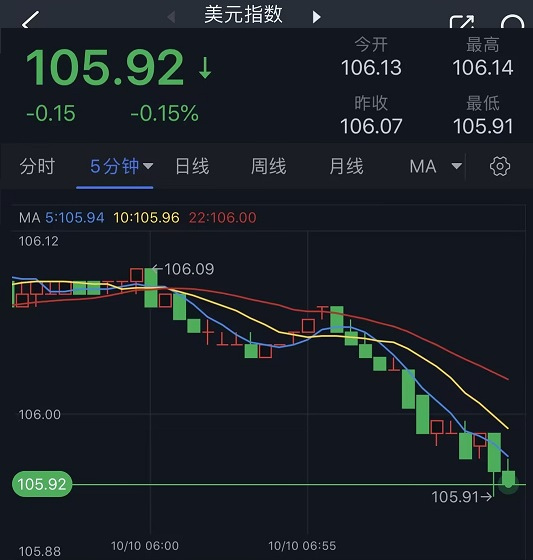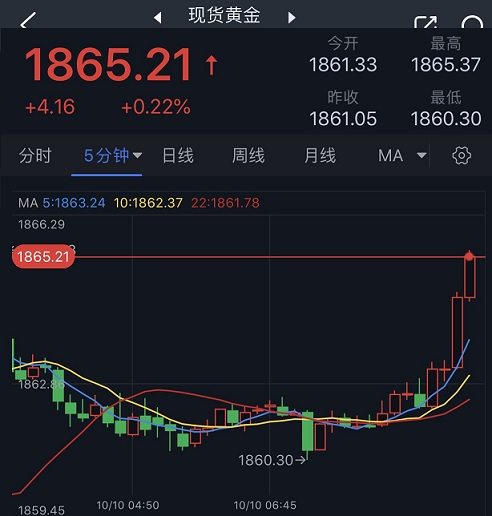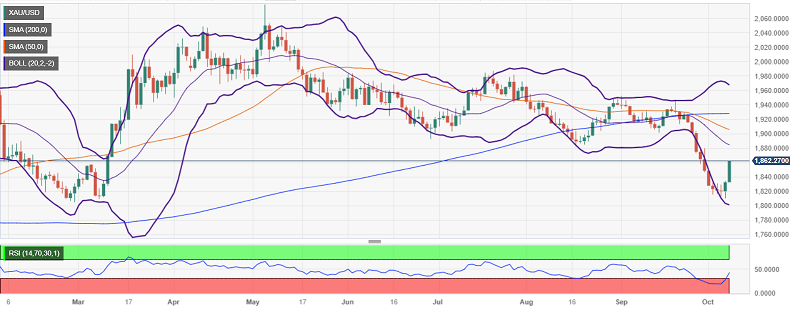On Tuesday (October 10th), in the early trading session of the Asian market, the US dollar index slightly declined, falling below 106 at one point and reaching a minimum of 105.91, setting a new low in over a week. Spot gold rose slightly, reaching a maximum of $1865.21 per ounce. Analysts pointed out that Fed Vice Chairman Jefferson and Dallas Fed Chairman Logan made dovish remarks on Monday, which suppressed the trend of the US dollar and boosted gold prices.

(5-minute chart of the US dollar index)

(5-minute chart of spot gold)
Federal Reserve officials' pigeon raising impact overshadows safe haven buying, hitting the US dollar
Philip Jefferson, Vice Chairman of the Federal Reserve, hinted on Monday that the yield of long-term US treasury bond bonds may prevent the Federal Reserve from further raising short-term policy interest rates, and let the financial market replace the formal monetary policy measures of the Federal Reserve. The rise in the yield of long-term treasury bond will directly affect the financing costs of households and enterprises.
In his speech at the National Association for Business Economics, he stated that the tightening of the financial environment caused by rising bond yields will be borne in mind when evaluating future policy paths, and that caution is needed when further raising the benchmark federal funds rate.
Jefferson said, "Officials can be cautious when evaluating the degree of additional policy tightening that may be necessary. Looking ahead, I will continue to pay attention to the tightening of the financial environment caused by rising bond yields, and will keep this in mind when evaluating future policy paths
Since the September meeting, the yield of the US 10-year treasury bond bond has climbed about 40 basis points.
At the same time, Dallas Fed Chairman Lorie Logan previously stated in an earlier speech at the same meeting that the recent surge in long-term Treasury yields may mean a reduced need for the Fed to raise interest rates again.
Logan said, "If long-term interest rates remain high due to an increase in term premiums, the necessity of raising interest rates may decrease
It is worth noting that Logan is one of the hawkish officials who support the Federal Reserve's continued interest rate hikes. Since serving as the chairman of the Dallas Fed last year, she has been supporting interest rate hikes.
However, Logan added that if the strong US economy is the reason for the rise in long-term interest rates, then the Federal Reserve may need to further tighten monetary policy.
In September of this year, the Federal Reserve decided to maintain the federal funds rate target range between 5.25% and 5.5%. Since March 2022, the Federal Reserve has raised interest rates 11 times to curb high inflation, raising them from near zero to their highest level in 22 years.
The safe haven buying sparked by the conflict between Palestine and Israel once provided upward momentum for the US dollar on Monday, but as Federal Reserve officials repeatedly made dovish remarks, the US dollar index continued to decline from its intraday high of 106.59.
Brad Bechtel, Global Head of Foreign Exchange Trading at Jefferies, said, "This is just a bit of risk aversion, not a large-scale panic, nor a large-scale sell-off. It's just a small step for the market to take to a safe place while watching the situation unfold. We are gradually getting used to the fact that geopolitical events usually only have a very brief impact on the market
As long as the conflict is limited to Israel and Hamas, we can go back and focus on economic fundamentals, "said Marc Chandler, Chief Market Strategist at Bannockburn Global Forex
According to data tracked by the Chicago Mercantile Exchange (CME), investors believe that the Federal Reserve will not raise interest rates again next month. The futures market pricing shows that the probability of the Federal Reserve maintaining interest rates unchanged at its November meeting is 88.5%.
Julia Coronado, President and Founder of MacroPolicy Perspectives, stated that recent comments from Federal Reserve officials, including those from San Francisco Fed Chairman Mary Daly last week, have reduced the likelihood of another rate hike.
Daley said at the time, "The tight bond market is already equivalent to a rate hike, so there is no need for further tightening
Multiple factors support a surge in gold prices
On Monday, gold prices hit their largest increase since May, with increased demand for safe haven after the Hamas attack on Israel. In addition, the decline of the US dollar index from its high point also boosted gold prices. Spot gold closed at $1861.05 per ounce on Monday, a significant increase of $29.23, or 1.60%.
FXStreet analyst Christian Borjon Valencia pointed out that the conflict between Israel and the Palestinian Islamic organization Hamas over the weekend sparked geopolitical turmoil, which impacted financial markets and boosted demand for gold's safe haven status.
Valencia stated that if geopolitical turmoil escalates, gold prices will continue to be supported by buying.
The current conflict between Palestine and Israel is still ongoing, resulting in over 1600 deaths on both sides. In political and economic turmoil, gold is often considered a safe means of storing value.
Gold is a safe haven during periods of political and economic turmoil. Bob Haberkorn, senior market strategist at RJO Futures, said that there are many variables in the situation in the Middle East, and if the situation further heats up, gold may move towards $1900 per ounce.
Valencia said that another reason driving the gold price higher was the decline of the yield of US treasury bond bonds (especially the real yield). The yield of 10-year inflation protected bonds (TIPS) in the United States remained at 2.47%, while the yield of 10-year treasury bond bonds plunged 15 basis points from 4.797% to 4.657%. This week, inflation data from US producers and consumers will be crucial in determining the next steps of the Federal Reserve.
Analysis of the Prospects of Gold Technology
Valencia stated that after bottoming out near $1810.00 per ounce, gold resumed an upward trend due to risk aversion, and buyers focused on the next resistance level, the 20-day moving average of $1884.00 per ounce.
If the gold price breaks through the 20 day moving average, it will target the 50 day moving average of $1905.52/ounce, followed by the 100 day moving average of $1925.73/ounce and the 200 day moving average of $1928.75/ounce.

(Spot Gold Daily Chart)
Valencia added that on the other hand, if gold prices fail to break through the 20-day moving average, it will open the door for a pullback. The first support level for gold prices will be last week's low of $1810 per ounce, followed by $1800 per ounce.
In terms of the crude oil market, oil prices surged by more than 4% on Monday, recovering some of last week's losses due to concerns that the escalation of the military conflict between Israel and the Palestinian Islamic organization Hamas may affect Middle Eastern oil supply. Brent crude oil closed up $3.57, or 4.2%, at $88.15 per barrel. US crude oil closed at $86.38 per barrel, up $3.59 or 4.3%.
In terms of the US stock market, major US stock indices closed higher on Monday, while energy stocks rebounded as investors digested the latest news about the conflict between Israel and the Palestinian Islamic organization Hamas. The Dow Jones Industrial Average rose 197.07 points, or 0.59%, to 33604.65; The S&P 500 index rose 27.16 points, or 0.63%, to 4335.66 points; The Nasdaq Composite Index rose 52.90 points, or 0.39%, to 13484.24.


